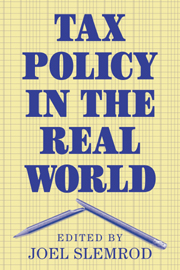Book contents
- Frontmatter
- Contents
- List of contributors
- 1 The real world of tax policy
- 2 Federal tax reform
- 3 Federalism and subfederal taxes
- Threading the fiscal labyrinth: some issues in fiscal decentralization
- A policymaker's guide to fiscal decentralization
- Fiscal decentralization and economic development
- Federalism and reductions in the federal budget
- Issues raised by the new federalism
- Fiscal equalization and school finance
- The case for equalizing aid
- Fiscal equalization: an empty box?
- How would you know a good economic development policy if you tripped over one? Hint: don't just count jobs
- Jobs, productivity, and local economic development: what implications does economic research have for the role of government?
- 4 Principles, politics, and the professors
- Index
Fiscal equalization: an empty box?
Published online by Cambridge University Press: 01 June 2010
- Frontmatter
- Contents
- List of contributors
- 1 The real world of tax policy
- 2 Federal tax reform
- 3 Federalism and subfederal taxes
- Threading the fiscal labyrinth: some issues in fiscal decentralization
- A policymaker's guide to fiscal decentralization
- Fiscal decentralization and economic development
- Federalism and reductions in the federal budget
- Issues raised by the new federalism
- Fiscal equalization and school finance
- The case for equalizing aid
- Fiscal equalization: an empty box?
- How would you know a good economic development policy if you tripped over one? Hint: don't just count jobs
- Jobs, productivity, and local economic development: what implications does economic research have for the role of government?
- 4 Principles, politics, and the professors
- Index
Summary
Fiscal equalization is the process through which a central government makes funds available to lower level governments with the objective of reducing the degree of inequality in the revenues that such governments can raise using their own revenue instruments. While the proximate objective is concerned with revenues, the ultimate objective may be to reduce inequalities in public expenditure. Equalization policies have been advocated on both efficiency and equity grounds. In this essay, we shall critically examine these arguments and demonstrate that the case for equalization is weaker than generally thought. Nevertheless, a case can be made for a policy which is directed to assist those governments with constituencies which are disproportionately poor. While such a policy could be labeled as equalization, it may more properly be viewed as an extension of the logic of centralizing the costs of income redistribution in a federal system.
FISCAL DISPARITIES
The flip side of equalization is the concept of fiscal disparities—i.e., those differences that equalization is supposed to remove. We begin the discussion, therefore, by identifying alternative measures of fiscal disparities that have been discussed in the literature.
In the broadest sense, fiscal disparities can be defined as differences in fiscal effort required to achieve a particular fiscal outcome. Some authors have been content to define outcomes in terms of revenues, while others have been more ambitious, measuring fiscal outcomes in terms of levels of public services.
- Type
- Chapter
- Information
- Tax Policy in the Real World , pp. 237 - 248Publisher: Cambridge University PressPrint publication year: 1999
- 2
- Cited by



